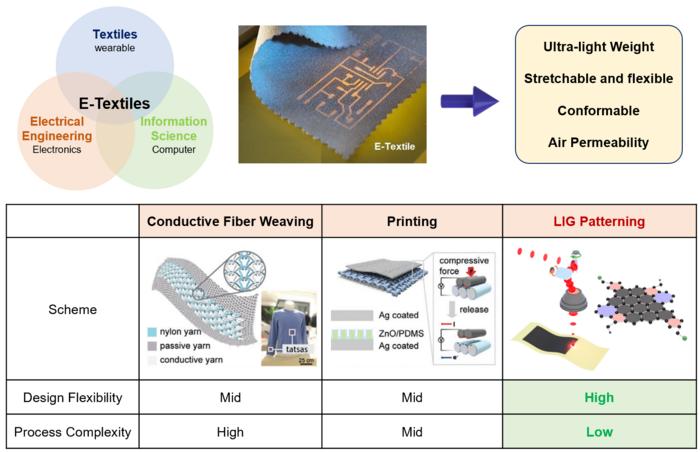| Oct 26, 2023 |
Multimodal graphene-based e-textiles
(Nanowerk News) For the first time ever, a joint research team from the Korea Institute of Machinery and Materials (KIMM) and the Korea Advanced Institute of Science and Engineering (KAIST) has developed customized electronic textiles using graphene. The groundbreaking technology was led by Principal Researcher Soongeun Kwon of KIMM’s Department of Nano Manufacturing Technology and Professor Young-Jin Kim from KAIST’s Department of Mechanical Engineering.
|
|
Their research was published in ACS Nano ("Multimodal E-Textile Enabled by One-Step Maskless Patterning of Femtosecond-Laser-Induced Graphene on Nonwoven, Knit, and Woven Textiles").
|
 |
| (Above) Introduction on e-textiles and (below) comparison of methods for manufacturing e-textiles. (Image: Korea Institute of Machinery and Materials)
|
|
This innovative approach uses multimodal capabilities, meaning it can exchange information through various sensory interfaces like visual and auditory sensations. What sets this technology apart is its method for creating patterns on textiles. Traditionally, electrically conductive textiles have been made by either coating fabrics with conductive ink or by attaching a thin, functional layer onto generic fabrics. These methods are cumbersome and often involve the use of harmful chemicals, making them less suitable for mass production.
|
|
In a departure from these conventional methods, the team used laser direct patterning technology to create laser-induced graphene (LIG) on the fabric. This process involves irradiating a high-power laser onto the surface of a garment, converting light energy into thermal energy and instantaneously creating a carbon material similar to graphene.
|
|
This unique process results in textiles with exceptional electrical conductivity, achieved through the application of femtosecond laser processing technology. This technology uses ultra-short lasers, minimizing damage to the materials and enabling high-resolution patterns.
|
|
The environmental benefits of this technology are significant. Because it doesn’t require the use of toxic chemicals or additional processing, these e-textiles can be manufactured in an eco-friendly manner. The technology opens up new possibilities for creating industrial and military apparel for personal health management, as well as customizable smart clothes in the healthcare sector.
|
|
Soongeun Kwon expressed the importance of this breakthrough, stating, “We have developed this technology by studying the structures of generic fabrics and transforming them into graphene-based materials with advanced features. The method is not only eco-friendly but also conducive to mass production of customized e-textiles.”
|

